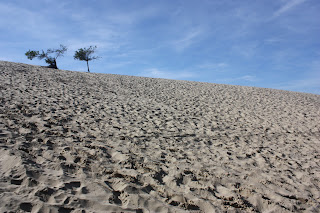When you start to feel warm and fuzzy at the sight of trees turning fall colours and you expect rain when you see a little mist in the valley and you know that once it starts it won’t stop for a very long time, you’re starting to get just a little homesick. So you remind yourself there are still plenty of beautiful places to visit and sights to see on your northward trek: like taking the scenic byway route instead of the I-5, along the Umqua River through the Umqua Valley toward the Oregon Coast. Even when we weren’t within sight of the blue, green and brown lady meandering through the valley, we wound through gorgeous open range farmland; if you painted the slow cattle grazing in the gold and green fields around white wood-sided houses and red barns, no one would believe it to be true.
On a less picturesque note, we stopped at McDonalds in Sutherlin, OR and ordered a couple of smoothies to legitimize our using their restrooms. Frank suffered his first brain freeze in many a year but was somewhat compensated by his winning an Angus burger in their Monopoly game. Closed door, opened window.
Near the mouth of the Umqua, just before Reedsport, we encountered yet another wildlife surprise. A herd of elk, mostly females, were lazing about in a field or chomping on whatever delicacies the creek had to offer. Young males fraternized with the females while an older buck lay in the grass apart from the group no doubt watching over his harem.
The coast of Oregon is breathtaking – and incongruous. Thick green forests so lush you can smell the dampness open onto soft white “mountains” of sand sprouting dry shrubs and windblown grasses. In fact, we drove for days across the interior deserts of the US and never saw as much sand as we saw in the dunes of one Oregon State park on the coast.
Once we left the Oregon dunes behind, blue water and white surf constantly in violent motion took over the coastal vista. Where there isn’t a soft white sand beach, there is black rock which pushes up “haystacks” just off shore.
 Cape Foulweather, just south of Newport, was discovered in 1778 by Captain James Cook and was his first landing point on the Pacific Coast. He apparently landed in bad weather with winds up to 100 mph and gave it the name that holds today. Other than the obvious description of the weather he encountered, I would love to read about his impressions of this beautiful rugged, violent coastline.
Cape Foulweather, just south of Newport, was discovered in 1778 by Captain James Cook and was his first landing point on the Pacific Coast. He apparently landed in bad weather with winds up to 100 mph and gave it the name that holds today. Other than the obvious description of the weather he encountered, I would love to read about his impressions of this beautiful rugged, violent coastline.We stopped so often along the coast that we fell short of our original destination of Cannon Beach. We revised it to Lincoln City and finally settled on Depoe Bay. After watching the surf crash against the shore and billow over the wall onto the sidewalk, we booked a room at the Troller’s Inn. Our room is very quaint with pretty touches such as antique furniture, hand knocked mats, a wrought iron style headboard and a quilted coverlet. (And all within our budget).
Until tomorrow. . . .





No comments:
Post a Comment